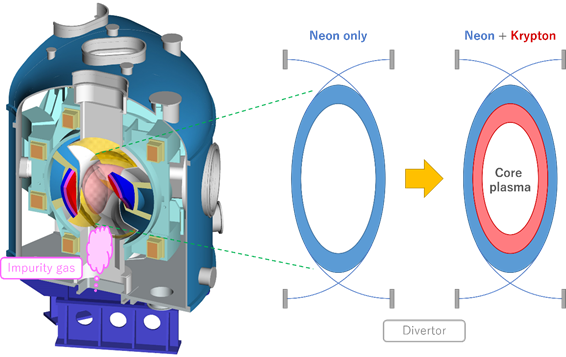Realization of stable heat-load reduction on wall using two-species impurity gas injection
Stable and effective heat load reduction on the wall was realized using neon and krypton injection compared with single-species injection in the Large Helical Device (LHD). Since heat load on the wall should be reduced in fusion reactors, an operational method is investigated to disperse the heat load as plasma radiation using impurity gas injection into the plasma (divertor detachment). This achievement will contribute to develop the operational method of stable divertor detachment.

In fusion reactors, a reaction occurs by confining high-temperature plasma exceeding 100 million degrees Celsius. Due to the flow of plasma from the core plasma with a high temperature to a place called the "divertor" in the wall of the device, it is necessary to suppress the local heat load of the divertor. Therefore, an operational method called "divertor detachment" is being investigated, in which impurities are injected around the edge plasma and the heat load is dispersed as radiation. In the Large Helical Device (LHD), we conducted experiments on the divertor detachment.
In the divertor detachment experiments, typically, one species of impurity (nitrogen, neon, argon, krypton, etc...) is injected. On the other hand, the LHD research group conducted the experiment using the injection of two species of impurities (neon and krypton) to explore a more advanced operational method. As a result, we succeeded in stably maintaining the diverter detachment, which previously could only be maintained for about 0.2 s with one-species impurity injection and for about one second with two-species impurity injection.
It was found that in the two-species injection, the radiation of krypton increased by neon injection. Due to the phenomenon, the divertor heat load could be effectively reduced by the increase of plasma radiation with a smaller amount of impurities. Moreover, accumulation of the injected impurities toward the core plasma was suppressed. We also found that there were optimal conditions for the phenomenon regarding the electron temperature and electron density around the edge plasma.
Since fusion reactors need to operate stably, it is necessary to maintain a stable divertor detachment. In addition, if the injected impurities for the divertor detachment are accumulated toward the core plasma, the fusion output power will decrease; therefore the influence of the impurities must be limited to the edge plasma. This result has provided important insights that will lead to the establishment of operational methods for the divertor detachment.
This work was supported by the JSPS KAKENHI "Development of plasma radiation imaging diagnostic in neutron environment" (17K14900) and "Realization of high-sensitivity imaging diagnostics of plasma radiation for divertor detachment research" (19K14689), and was performed by the research group of Dr. Kiyofumi Mukai at NIFS in collaboration with Dr. Hirohiko Tanaka at Nagoya University, Mr. Toshiki Kinoshita and Mr. Hikona Sakai at Kyushu University.
This research result was published on October 25, 2021 in Nuclear Fusion, a journal on controlled thermonuclear fusion by the International Atomic Energy Agency.
